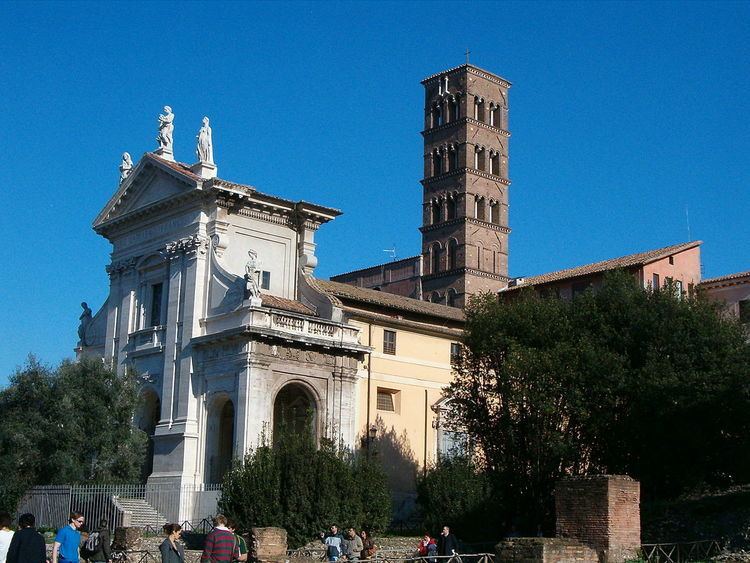Phone +39 06 679 5528 | Architect Carlo Lombardi | |
 | ||
Address Piazza Santa Francesca Romana, 4, 00186 Roma, Italy Burials Pope Gregory XI, Giambattista Orsini, Enrico Sibilia Similar Temple of Venus and Roma, Santa Maria Antiqua, Santi Cosma e Damiano, Temple of Antoninus and Faust, Basilica of Maxentius | ||
Santa Francesca Romana (Italian: Basilica di Santa Francesca Romana) , previously known as Santa Maria Nova, is a church in Rome, Italy, situated next to the Roman Forum in the rione Campitelli.
Contents
History
The church was built in the second half of the tenth century, incorporating an eighth-century oratory that Pope Paul I excavated in the wing of the portico of the Temple of Venus and Roma; it was named Santa Maria Nova (or "Nuova", "new St. Mary"), to distinguish it from the other Roman Forum church devoted to St. Mary, Santa Maria Antiqua ("ancient St. Mary"), which had become dilapidated in the tenth century; it was rebuilt by Pope Honorius III in the thirteenth century, when the campanile was built and the apse was decorated with mosaics of a Maestà, the Madonna enthroned accompanied by saints. The interior has been altered since. Since 1352 the church has been in the care of the Olivetans. In the 16th century, the church was rededicated to Frances of Rome (Francesca Buzzi), who was canonized in 1608 and whose relics are in the crypt. Its travertine porch and façade is by Carlo Lambardi, and was completed in 1615.
The inscriptions found in Santa Francesca Romana (S. Maria Nuova), a valuable source illustrating the history of the church, have been collected and published by Vincenzo Forcella.
The interior, a single nave with side chapels, was rebuilt by Lombardi in the years preceding Francesca Buzzi's canonization, beginning in 1595. In the middle of the nave is the rectangular schola cantorum of the old church, covered in Cosmatesque mosaics. Another prominent feature is the confessional designed by Gian Lorenzo Bernini (1638–49), in polychrome marbles with four columns veneered in jasper.
The church houses the precious Madonna Glycophilousa ("Our Lady of Tenderness"), an early 5th-century Hodegetria icon brought from Santa Maria Antiqua. The twelfth-century Madonna and Child that had been painted over it was meticulously detached from the panel in 1950, and is now kept in the sacristy.
The ancient oratory on which the current church was built was located by Pope Paul I on the place in which Simon Magus died. According to this legend, Simon Magus wanted to prove his powers as stronger than those of the apostles, and started levitating in front of Sts. Peter and Paul. The two apostles fell on their knees preaching, and Simon fell, dying. The basalt stones where the apostles were imprinted by the knees of the two apostles and are embedded in the wall of the south transept.
The tomb of Pope Gregory XI, who returned the papacy to Rome from Avignon, reconstructed to a design by Per Paulo Olivieri (signed and dated 1584) is in the south transept.
The Deaconry was suppressed on 8 August 1661. S. Maria Nova was reestablished, as the Titulus of a Cardinal Priest, on 17 March 1887 by Pope Leo XIII. The titulus of the church remains Sancta Mariae Novae; the current Cardinal Priest of the Titulus S. Mariae Novae is Angelo Sodano. A Cardinal Priest no longer has any jurisdiction over his titular church or its clergy. He is only the Cardinal Protector.
Saint Francesca Romana has been named the patron of car drivers, because of a legend that an angel used to light her way with a lamp when she travelled at night. Automobiles line up on the day of her feast (9 March) as far as the Colosseum, to partake of the blessing.
The facade of the Church of Holy Cross College, in Clonliffe in Dublin, Ireland, is a replica of Santa Francesca Romana. It was designed by the Gothic Architect J.J. McCarthy and is the only exception to his list of Gothic works.
